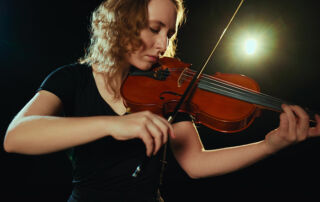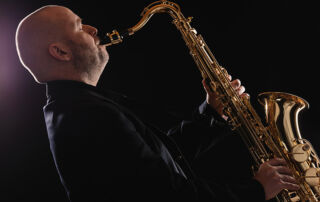
What is a bow?
A bow is a wooden stick with a bundle of horsehair attached to it.
It is used to play certain stringed instruments, such as the violin, viola, cello, double bass, octobass, and viola da gamba.
How does it work?
The friction of the bow hair on the strings creates a vibration, a sound that is amplified by the body of the instrument.

The different parts that make up a bow are:
- The hair, the stick, the frog, the screw, and the tip plate
The hair made from horsehair (taken from the tail of a stallion or gelding; mare's hair, damaged by urine, is not used) and stretched between the tip and the frog of the bow.
White hair is generally used, but black hair is sometimes preferred, as it allows for a more aggressive attack and grip, particularly suited for double bass players.
It is named for its resemblance to an arc (the bow was originally shaped like an arc).
To ensure better grip of the hair on the strings, rosin (dried pine resin) is applied to the hair.
The hair can be replaced by a bow maker (when too many hairs are broken) through a process called rehairing.
It is also possible to clean the hair by soaking it in a solvent that dissolves the rosin without damaging the hair when dust and dirt stick to the rosin-coated hair.
The stick
Most often made of Brazilian wood, pernambuco, but also snakewood, ironwood, and sometimes carbon fibre, it must be flexible and resilient.
The bow maker uses a straight stick, bending it for thirty minutes over the edge of a table above a heat source.
The stick takes on a slightly inward curve (a shape invented by François Xavier Tourte), as opposed to its earlier, more outwardly curved form.
François Xavier Tourte (1747-1835), originally a watchmaker, dedicated his life to seeking perfection, experimenting with shapes and materials best suited to serve the art of sound.
The frog
It is the part that, by sliding, adjusts the tension of the hair. It is made of ebony and metal, but can also be found in bone, ivory, or tortoiseshell, and is typically adorned with a mother-of-pearl inlay.
The screw
The screw is the mechanism for adjusting the tension of the hair. Connected to the nut above the frog and fitted inside the stick, it allows the frog to move along the stick.
The tip plate
Made of ivory, bone, gold, or silver, the tip plate protects the bow's head from impact.
Famous French bow makers include: Peccatte, Sartory, Fétique, Bazin, Morizot, Lotte, Ouchard and Lamy

The history of the bow
The earliest iconographic records date from the 10th century and show highly curved bows, with the hair apparently tied at both ends, and the musician holding the bow by a type of handle.
From the Renaissance through the 17th century, bows depicted in paintings and drawings have thin, slightly curved sticks, ending in a tapered point.
From the 17th century onward, the bow was the subject of extensive research, leading to high-quality, straight sticks in the 18th century, perfectly suited to the style of music for which they were intended.
From the 19th century, Romanticism introduced a new expressiveness, and bow design changed. Around 1770, Tourte created the slightly concave stick.
Today, bow makers replicate pre-1750 bows to meet the demand for early music.

Are there differences between bows for different instruments?
Double bass bows come in two types: the French bow, similar in shape and technique to violin bows, and the German bow, which uses a different technique closer to the bow hold of the viola da gamba.
Violin bows are the longest and lightest. As we move to lower-pitched instruments, the bows become shorter and heavier.
A violin bow weighs between 55 and 65 grams, a cello bow around 80 grams, and a double bass bow about 135 grams.

Is there an alternative material to horsehair for the bow hair?
Yes! After several years of research, musician-researchers have discovered a fibre with the same characteristics as high-quality horsehair.
This synthetic hair is highly durable and has an extended lifespan, allowing it to be used for several years without needing replacement.
In Mongolia, the birthplace of horsehair production, summers are becoming increasingly dry, and winters more snowy.
The local flora, the primary food source for horses, is greatly affected, which has a direct impact on the consistent quality of the horsehair.
Producers have had to lower their selection standards, and some chemically bleach the hair, which significantly weakens it.

How to take care of your bow?
Cellists who use a soft case, always remember to remove your bow before your cello to prevent the case from folding over and damaging the bow once the instrument is removed.
After each use, remember to loosen your bow and wipe the stick with a soft cloth to remove any rosin dust.
Do not tighten the hair too much and make sure you have enough space to play without hitting a music stand, a wall, or a fellow musician.






